While the above is a great start from an email marketing standpoint, don’t forget about your email infrastructure.
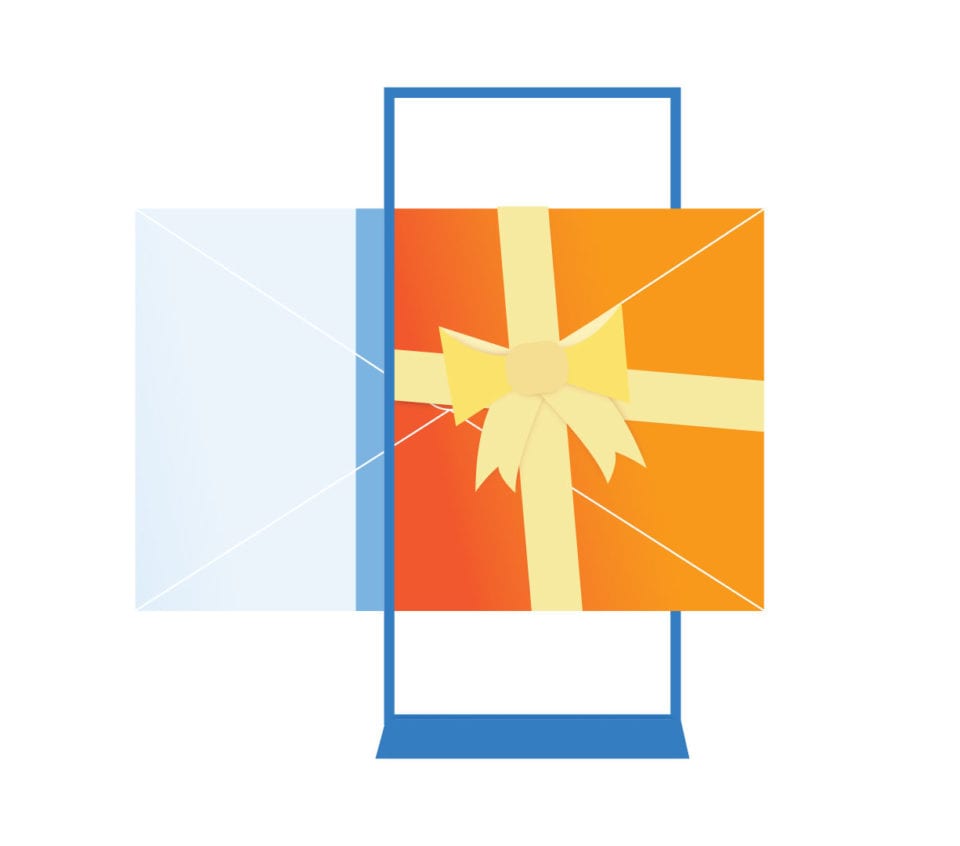 If you’re just starting your email program or are planning to send quite a bit more than average during the holiday season, your email infrastructure must be ready to handle the increase in sending.
This often involves warming up your IPs and completing your sender authentication. We won’t go into detail in this blog post on technical email infrastructure best practices (the post is long enough as it is), but you can check out the following resource for more information: Holiday Sending 101.
Holiday email marketing ideas have arrived!
To inspire your campaigns, we’ve included a couple of holiday email examples that caught our eye and convinced us to take action. Think about how you can use similar concepts for your holiday email marketing campaigns.
If you’re just starting your email program or are planning to send quite a bit more than average during the holiday season, your email infrastructure must be ready to handle the increase in sending.
This often involves warming up your IPs and completing your sender authentication. We won’t go into detail in this blog post on technical email infrastructure best practices (the post is long enough as it is), but you can check out the following resource for more information: Holiday Sending 101.
Holiday email marketing ideas have arrived!
To inspire your campaigns, we’ve included a couple of holiday email examples that caught our eye and convinced us to take action. Think about how you can use similar concepts for your holiday email marketing campaigns.
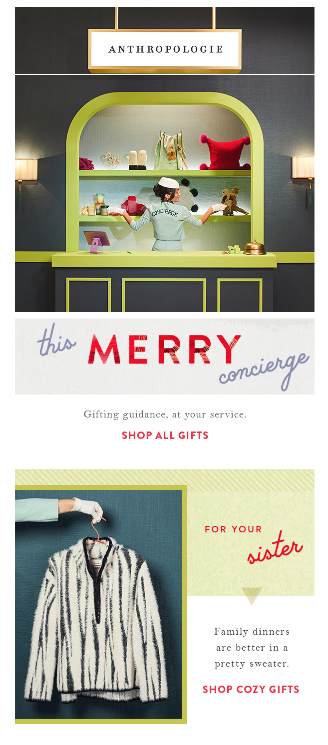 You’ll find many of the best holiday email examples are in “gift guide” format—like this one from Anthropologie suggesting different items for various family members. Sent at the end of October, the goal of this email was to get people thinking about their Christmas shopping list and to position Anthropologie as a great place to start Christmas shopping.
A gift guide is an excellent strategy to help recipients discover what they need to purchase for their loved ones without feeling the overly salesy push to buy.
In the spirit of the holidays, take a step back from the rigmarole of holiday sales and send a simple, caring message from the CEO or founder.
In this holiday email from ThirdLove, the CEO stands out with a plaintext email that explains their initiative: For every bra purchased, ThirdLove will donate a bra to a victim of the California wildfires.
Much like a thank you email, a simple message from the CEO can also express thanks to subscribers for making the year possible or to reflect on the year.
You’re in the thick of Black Friday, Small Business Saturday, or Cyber Monday sales, and you want to make a splash. So you decide to write “Black Friday” in all caps with 5 exclamation points and a few emojis at the end. That will get their attention, right? Nope! We’ve found that the emails that stand out the most are the ones that don’t include “Black Friday” in the subject line.
This holiday email example from Nordstrom solicits attention on Black Friday because it plainly shares the offer in the subject line: “Boots up to 60% off.” And when clicked on, it provides exactly as promised.
Many of the best Black Friday holiday emails examples you’ll see keep it simple and straightforward.
You’ll find many of the best holiday email examples are in “gift guide” format—like this one from Anthropologie suggesting different items for various family members. Sent at the end of October, the goal of this email was to get people thinking about their Christmas shopping list and to position Anthropologie as a great place to start Christmas shopping.
A gift guide is an excellent strategy to help recipients discover what they need to purchase for their loved ones without feeling the overly salesy push to buy.
In the spirit of the holidays, take a step back from the rigmarole of holiday sales and send a simple, caring message from the CEO or founder.
In this holiday email from ThirdLove, the CEO stands out with a plaintext email that explains their initiative: For every bra purchased, ThirdLove will donate a bra to a victim of the California wildfires.
Much like a thank you email, a simple message from the CEO can also express thanks to subscribers for making the year possible or to reflect on the year.
You’re in the thick of Black Friday, Small Business Saturday, or Cyber Monday sales, and you want to make a splash. So you decide to write “Black Friday” in all caps with 5 exclamation points and a few emojis at the end. That will get their attention, right? Nope! We’ve found that the emails that stand out the most are the ones that don’t include “Black Friday” in the subject line.
This holiday email example from Nordstrom solicits attention on Black Friday because it plainly shares the offer in the subject line: “Boots up to 60% off.” And when clicked on, it provides exactly as promised.
Many of the best Black Friday holiday emails examples you’ll see keep it simple and straightforward.
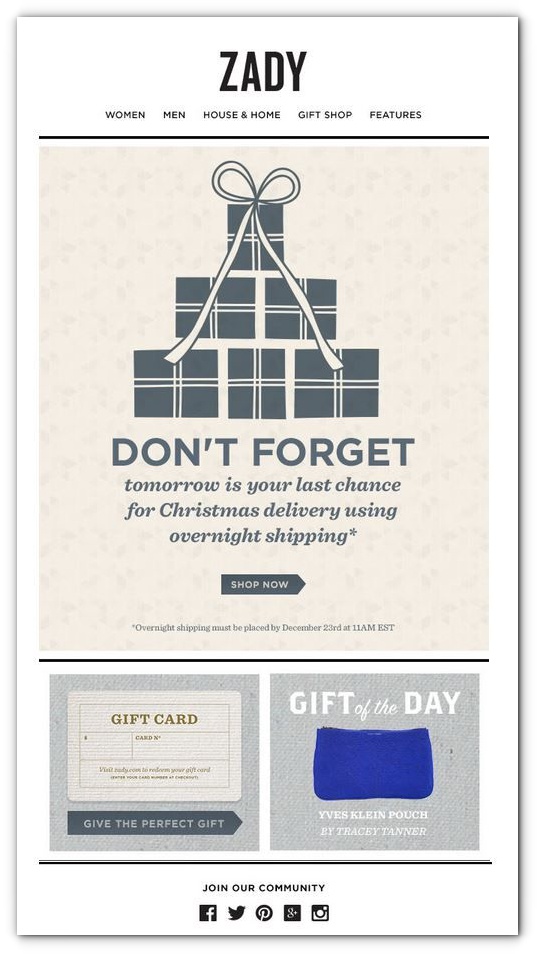 As you get closer to the big day, the focus will shift to stocking-stuffer bargains and hot-ticket items available with quick shipping as last-minute gifts.
Note how in this holiday email marketing example, Zady assures readers they can still get their gifts on time if they choose “overnight shipping” and complete their orders by the following day. It also inspires by showing a popular “gift of the day” suggestion and offers an easy out for people tired of browsing: The oh-so-perfect gift card.
People are frantic at this point. Take a load of stress off and keep it simple.
Want more ideas? Try this retail holiday email template for inspiration.
One thing that has changed from 2020-2021 is that we’re able to gather a little more freely in most locations. Send out an email or a series of emails promoting the festivities.
Keep these emails short and sweet with a visual flyer that shows the “who, what, where, why, when, and how,” as you can see in the Peninsula Shopping Center in Palos Verdes’ holiday promo at Old Navy.
As you get closer to the big day, the focus will shift to stocking-stuffer bargains and hot-ticket items available with quick shipping as last-minute gifts.
Note how in this holiday email marketing example, Zady assures readers they can still get their gifts on time if they choose “overnight shipping” and complete their orders by the following day. It also inspires by showing a popular “gift of the day” suggestion and offers an easy out for people tired of browsing: The oh-so-perfect gift card.
People are frantic at this point. Take a load of stress off and keep it simple.
Want more ideas? Try this retail holiday email template for inspiration.
One thing that has changed from 2020-2021 is that we’re able to gather a little more freely in most locations. Send out an email or a series of emails promoting the festivities.
Keep these emails short and sweet with a visual flyer that shows the “who, what, where, why, when, and how,” as you can see in the Peninsula Shopping Center in Palos Verdes’ holiday promo at Old Navy.
 If you’re sending a series, start with a teaser, like “something big is coming,” a few weeks in advance. Then, send out the details and follow up with a reminder of “what’s in it for me?”
Communication doesn’t have to end with your event. Afterward, you can send out highlights from the event and offer anyone who missed it a chance to snag a discount or enter another giveaway launching in the coming weeks.
If you’re looking to promote a holiday event, consider this holiday event email template.
Get your emails on the nice list!
By early-to-mid November, your list should be pristine, your templates should be ready to roll, and your segments should be well-defined. But, as you know, there’s still work to do! You may not be able to make big changes, but you can certainly test small adjustments in your holiday email blasts. You’ll also need to keep an eye on your metrics, as well as the frequency of your sends.
Testing is what takes your email program to the next level. By sending out virtually the same email with one isolated variable changed, it allows you to directly attribute the greater success (or failure) of that email to that specific variable change.
So what do you test? Say you’re interested in increasing your open rate. You could test your sending address, your email subject line, or your preheader, just to name a few. When you’re testing, it’s best to choose just one of these variables to test at a time. Otherwise, you won’t know which change you made had the most (or least) impact.
For your holiday subject lines, consider testing:
If you’re sending a series, start with a teaser, like “something big is coming,” a few weeks in advance. Then, send out the details and follow up with a reminder of “what’s in it for me?”
Communication doesn’t have to end with your event. Afterward, you can send out highlights from the event and offer anyone who missed it a chance to snag a discount or enter another giveaway launching in the coming weeks.
If you’re looking to promote a holiday event, consider this holiday event email template.
Get your emails on the nice list!
By early-to-mid November, your list should be pristine, your templates should be ready to roll, and your segments should be well-defined. But, as you know, there’s still work to do! You may not be able to make big changes, but you can certainly test small adjustments in your holiday email blasts. You’ll also need to keep an eye on your metrics, as well as the frequency of your sends.
Testing is what takes your email program to the next level. By sending out virtually the same email with one isolated variable changed, it allows you to directly attribute the greater success (or failure) of that email to that specific variable change.
So what do you test? Say you’re interested in increasing your open rate. You could test your sending address, your email subject line, or your preheader, just to name a few. When you’re testing, it’s best to choose just one of these variables to test at a time. Otherwise, you won’t know which change you made had the most (or least) impact.
For your holiday subject lines, consider testing:
- Including emojis vs. no emojis
- Revealing the sales promo vs. keeping it a mystery
- Using discounts vs. dollar amounts
 When testing CTAs, play around with:
When testing CTAs, play around with:
- Bold colors vs. muted ones
- Action-oriented copy vs. product awareness copy
- Buttons vs. links
- Lots of CTAs vs. a few
Lastly, an important element you should consistently test is the time you send. Start with larger windows like morning vs. afternoon or afternoon vs. evening. Then narrow down the time frame until you find the sweet spot.
We’ve also found it helpful to send at an “off” time. Most email marketers will choose to send their emails on the hour, 5 minutes, 15 minutes, or 30 minutes after the hour. So sending at, say, 10:37 a.m. should help you avoid swamped servers and potential email delays.
The possibilities for testing are endless, so don’t get overwhelmed. Remember that even though it will take you longer to test each variable one by one, it’s worth it in the long run. Your subscribers matter, and learning what they respond to best is just one way to show them you care.
Check out our guide on A/B testing for more detailed testing advice and tips.
 Email is a communication tool often abused by senders around the holidays. What used to be a weekly newsletter can morph into multiple daily emails.
Yes, recipients will probably anticipate a slightly higher volume of emails hitting their inbox because the holidays are exciting and worthy of more communication. But, forgetting to honor email preferences is a quick way to turn any recipient into Scrooge with the “Spam” button.
Email is a communication tool often abused by senders around the holidays. What used to be a weekly newsletter can morph into multiple daily emails.
Yes, recipients will probably anticipate a slightly higher volume of emails hitting their inbox because the holidays are exciting and worthy of more communication. But, forgetting to honor email preferences is a quick way to turn any recipient into Scrooge with the “Spam” button.
Make sure your messages are valuable, timely, and in line with the expectations you set during the rest of the year.
How do you know if you’re sending too much?
Your engagement metrics (opens, clicks, unsubscribes) are your window into your recipients’ inboxes. But, your subscribers’ engagement (or lack of engagement) tells you what kind of content they like to receive. If you see a steady decline in engagement after you increase your sending frequency, then you probably need to pull back your sending.
With an increase in frequency, both your engagement rate and your unsubscribe rate are likely to worsen. So decide before you send what’s too much. This number will depend on each email program as well as the goals for the campaign. But, determining the number ahead of time will help quell any anxiety that comes up when you start to see lower engagement rates and higher unsubscribes.
Successes from holidays past are the gifts that keep on giving!
Uber’s email “Flying to the feast?” snags the audience’s attention as Americans fly home for the holidays. Sent on the Sunday before Thanksgiving, it was timely, relevant, and short! We found that the emails with the highest engagement have 4 words in the subject lines.
Frequency is one of the most crucial elements in a successful holiday email blast. In the top-right corner, it shows 1/6. Toward the bottom, Uber says to check back each Sunday for more useful holiday tips. This scheduled plan of 6 emails, 1 per week, sets expectations from the beginning of the email series. Rather than inundating you with email deals daily, Uber looks to provide quality over quantity.
Recipients get bombarded with emails during the holiday season, and you don’t want to be a part of the noise that doesn’t get through. Remember, it doesn’t matter how many emails you send if the content isn’t useful or applicable.
Uber provides a solution to every traveler’s dilemma: How do I get to the airport? Do you drive and park, get a ride from a friend, order a cab? Nope! You can schedule your Uber ride in advance. By providing a solution to a common need over the holidays, Uber goes above and beyond in its email content.
To create the best holiday email campaigns, think about problems you can help your recipients solve. Can you make their seasonal shopping easier by providing a holiday gift guide? Or, can you suggest solutions to holiday travel, like Uber? Framing your content in this manner will position your emails as helpful rather than salesy or pushy.
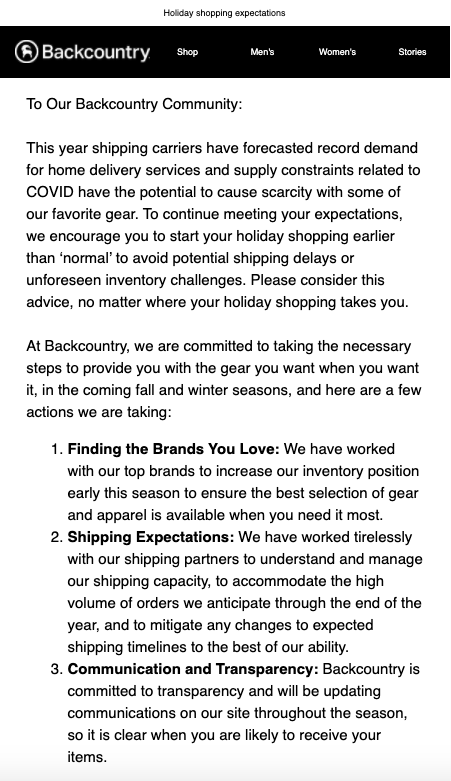 The best holiday email campaigns aren’t always the cutest or the most fun—and sometimes that’s what’s needed the most. Backcountry went for candor over chic with this holiday expectations email, and it comes off timely and appropriate for the 2021 holiday season. Instead of fluffy promises and optimistic predictions, Backcountry gives it straight to its customers.
Rather than waiting to see how the shipping season plays out, Backcountry avoids the “whoops” by giving its community fair expectations: If you want to buy the gear you know and love, you better do it soon because there’s no guarantee it will be in stock later.
It’s much better to set the expectations now rather than send delay notifications later. By creating a shipping estimate page and directing traffic there, Backcountry eliminates potentially hundreds or thousands of customer support tickets asking, “Why’s my order not here yet?”
The subject line of this email reads: “A message from our CEO.” Then, the email flows as if written by the CEO of the company, Melanie Cox, and her signature is even included at the bottom. Whether Cox actually wrote it or not isn’t the point—the point is that a bit of human flavor can go a long way.
By sending the email from the CEO, Backcountry makes the message more personal for its community. It’s not just an automated message or a just-so-you-know update from so-and-so at Backcountry—it’s an important message from the CEO who cares about her customers.
Frontier nails the urgency strategy with its “The cluck is ticking” email. It’s fun, timely, and encourages customers to make a decision quickly. The CTAs are clear and obvious, and the subject line, “Don’t CHICKEN out on 75% off flights!” ties it all together nicely.
The countdown clock adds a nice touch to this email. With just a day to spare, you could imagine the recipient starring this email or dragging it to their primary inbox, so they don’t forget.
Adding interactive elements to your email can be tricky, so start with something simple. Try using a GIF or an embedded survey to discover your recipients’ appetite for interactive content. If they respond well, then consider adding more to future campaigns.
It’s easy to forget your purpose when you start having fun with your emails, but Frontier brings it all back to focus. All the clever copy, bold fonts, and bright colors drive toward one thing: “BOOK NOW.”
When creating witty holiday email blasts, always remember the purpose of each email. Why are you sending it? What do you want customers to do with it? How will you measure success? With these metrics in mind, you’re more likely to stay on point and send effective campaigns.
The best holiday email campaigns aren’t always the cutest or the most fun—and sometimes that’s what’s needed the most. Backcountry went for candor over chic with this holiday expectations email, and it comes off timely and appropriate for the 2021 holiday season. Instead of fluffy promises and optimistic predictions, Backcountry gives it straight to its customers.
Rather than waiting to see how the shipping season plays out, Backcountry avoids the “whoops” by giving its community fair expectations: If you want to buy the gear you know and love, you better do it soon because there’s no guarantee it will be in stock later.
It’s much better to set the expectations now rather than send delay notifications later. By creating a shipping estimate page and directing traffic there, Backcountry eliminates potentially hundreds or thousands of customer support tickets asking, “Why’s my order not here yet?”
The subject line of this email reads: “A message from our CEO.” Then, the email flows as if written by the CEO of the company, Melanie Cox, and her signature is even included at the bottom. Whether Cox actually wrote it or not isn’t the point—the point is that a bit of human flavor can go a long way.
By sending the email from the CEO, Backcountry makes the message more personal for its community. It’s not just an automated message or a just-so-you-know update from so-and-so at Backcountry—it’s an important message from the CEO who cares about her customers.
Frontier nails the urgency strategy with its “The cluck is ticking” email. It’s fun, timely, and encourages customers to make a decision quickly. The CTAs are clear and obvious, and the subject line, “Don’t CHICKEN out on 75% off flights!” ties it all together nicely.
The countdown clock adds a nice touch to this email. With just a day to spare, you could imagine the recipient starring this email or dragging it to their primary inbox, so they don’t forget.
Adding interactive elements to your email can be tricky, so start with something simple. Try using a GIF or an embedded survey to discover your recipients’ appetite for interactive content. If they respond well, then consider adding more to future campaigns.
It’s easy to forget your purpose when you start having fun with your emails, but Frontier brings it all back to focus. All the clever copy, bold fonts, and bright colors drive toward one thing: “BOOK NOW.”
When creating witty holiday email blasts, always remember the purpose of each email. Why are you sending it? What do you want customers to do with it? How will you measure success? With these metrics in mind, you’re more likely to stay on point and send effective campaigns.
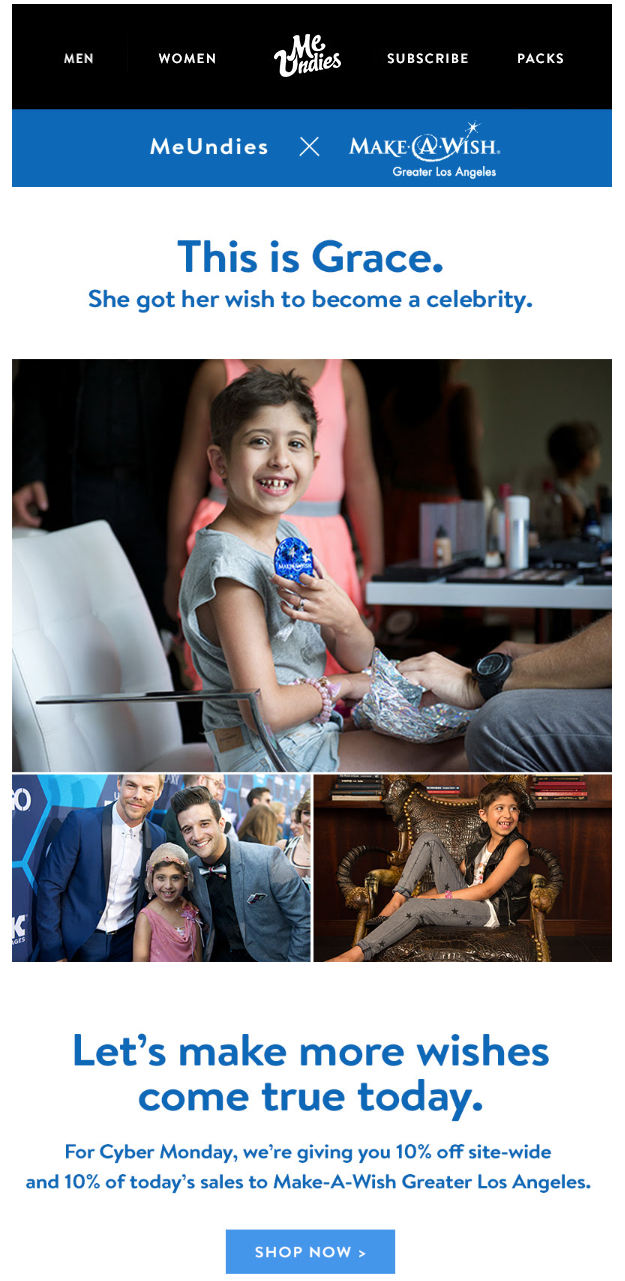 MeUndies has some great subject lines. My favorite from last year’s holiday season was, “Keep your pants on, it’s almost Black Friday.” It’s cheeky, makes you laugh, and elicits a read. Best of all, it supports a good cause and reminds us there’s more to the holidays than gifting.
We all get caught up in our own lives and our own brands and forget to step outside our respective bubbles. MeUndies’s “Cyber for good this Monday” email takes a very different approach from other Cyber Monday emails in the inbox.
Rather than pushing promotional deals and talking about its ultra-comfy products, it focuses on Grace, an 11-year-old girl with cancer who wishes to be a celebrity. MeUndies’s push to the website was to shop on Cyber Monday for 10% off, with 10% of the sales going to the Make-A-Wish Foundation.
It’s refreshing to have an email that isn’t solely focused on promotions, which is probably why subject lines without a percentage discount tend to perform better than those that do. But, if you’re nervous about taking your eye off the prize on the big day, then try testing it out first. See how your recipients engage with your promotional vs. cause emails leading up to Black Friday.
A simple call-to-action (CTA) button at the end of the copy directs recipients to shop for a good cause. But, let the content of your emails decide the tone of your CTA. Since this is a more heartfelt email, the simple copy fits in well with the overall message. For an email with more holiday pizzazz, get creative and test CTA copy that has some holiday flare.
MeUndies has some great subject lines. My favorite from last year’s holiday season was, “Keep your pants on, it’s almost Black Friday.” It’s cheeky, makes you laugh, and elicits a read. Best of all, it supports a good cause and reminds us there’s more to the holidays than gifting.
We all get caught up in our own lives and our own brands and forget to step outside our respective bubbles. MeUndies’s “Cyber for good this Monday” email takes a very different approach from other Cyber Monday emails in the inbox.
Rather than pushing promotional deals and talking about its ultra-comfy products, it focuses on Grace, an 11-year-old girl with cancer who wishes to be a celebrity. MeUndies’s push to the website was to shop on Cyber Monday for 10% off, with 10% of the sales going to the Make-A-Wish Foundation.
It’s refreshing to have an email that isn’t solely focused on promotions, which is probably why subject lines without a percentage discount tend to perform better than those that do. But, if you’re nervous about taking your eye off the prize on the big day, then try testing it out first. See how your recipients engage with your promotional vs. cause emails leading up to Black Friday.
A simple call-to-action (CTA) button at the end of the copy directs recipients to shop for a good cause. But, let the content of your emails decide the tone of your CTA. Since this is a more heartfelt email, the simple copy fits in well with the overall message. For an email with more holiday pizzazz, get creative and test CTA copy that has some holiday flare.
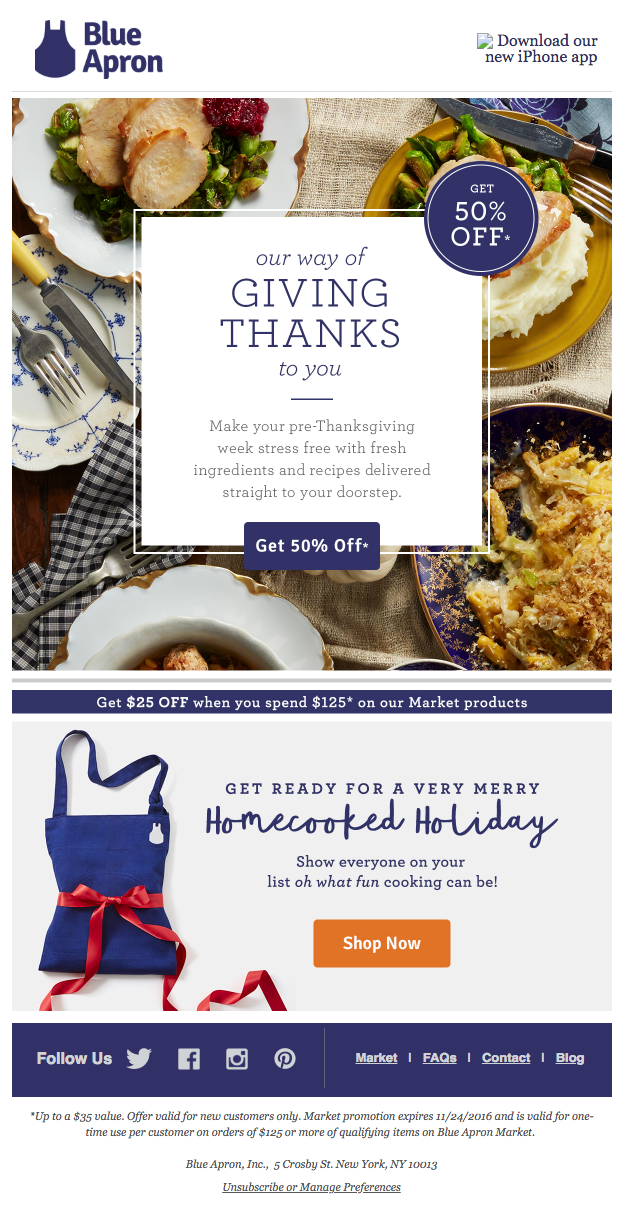 Consider staying away from the in-your-face, red-and-green flashing sale signs and the holiday email Christmas jingles. We can still have fun with the holidays without overstimulating (or sometimes annoying) our recipients.
Blue Apron does a great job of making you hungry as soon as you open its emails. Bright fall colors and savory meals are the centerpieces of its holiday emails. In your emails, think about how you want your recipients to feel. Do you want to evoke feelings of warm and cozy winter fires, crisp and brisk fall leaves, or icy storms?
It’s easy to spend hours creating your email, from building the template to choosing images and writing copy. Fortunately, there are enough tools out there that it doesn’t have to be a grueling process. With these great nonstock photo resources, you can find images that match how you want your recipients to feel.
Our free, ready-to-go holiday email marketing templates make adding images and content simple so that creating beautiful emails can be a quick, streamlined process.
Sometimes brands get a little carried away with the fa la’s and the ho hos in holiday email marketing. When you’re writing seasonal emails, remember this could be the 3rd, 12th, or even 30th email that recipients have read containing overly festive language.
Consider staying away from the in-your-face, red-and-green flashing sale signs and the holiday email Christmas jingles. We can still have fun with the holidays without overstimulating (or sometimes annoying) our recipients.
Blue Apron does a great job of making you hungry as soon as you open its emails. Bright fall colors and savory meals are the centerpieces of its holiday emails. In your emails, think about how you want your recipients to feel. Do you want to evoke feelings of warm and cozy winter fires, crisp and brisk fall leaves, or icy storms?
It’s easy to spend hours creating your email, from building the template to choosing images and writing copy. Fortunately, there are enough tools out there that it doesn’t have to be a grueling process. With these great nonstock photo resources, you can find images that match how you want your recipients to feel.
Our free, ready-to-go holiday email marketing templates make adding images and content simple so that creating beautiful emails can be a quick, streamlined process.
Sometimes brands get a little carried away with the fa la’s and the ho hos in holiday email marketing. When you’re writing seasonal emails, remember this could be the 3rd, 12th, or even 30th email that recipients have read containing overly festive language.
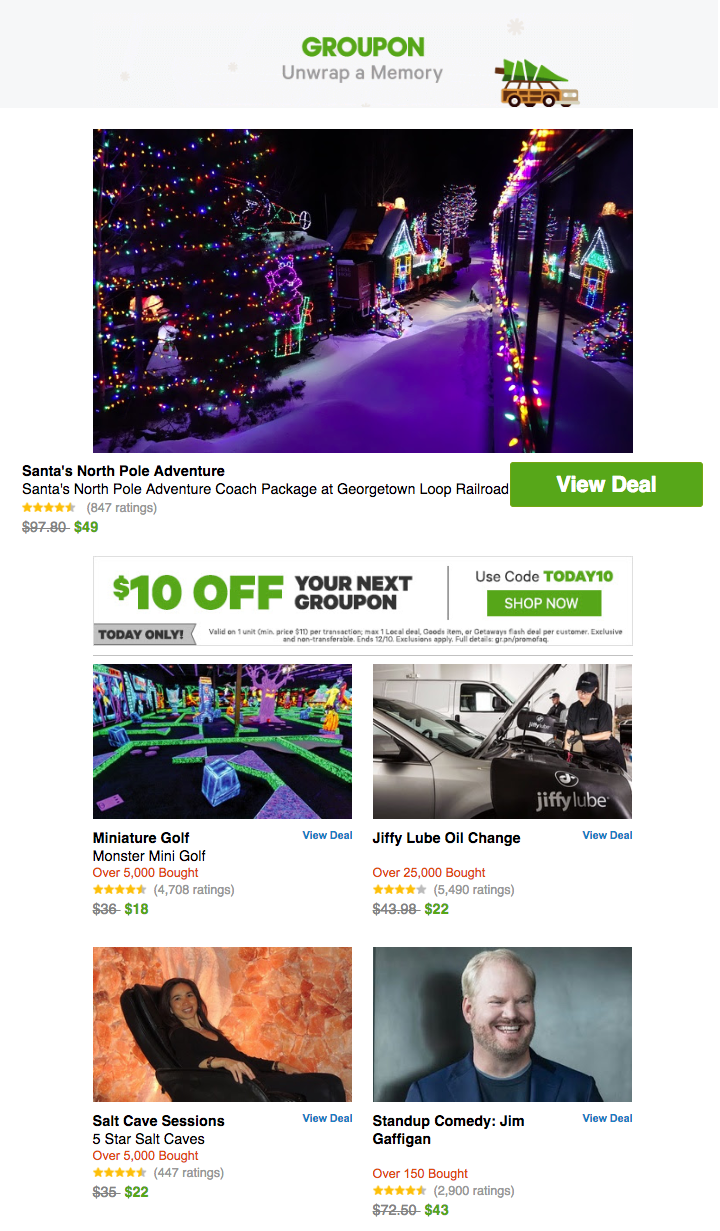 Take advantage of the fun holiday jingles and terminology but don’t go overboard. In Blue Apron’s theme, it has fun with Thanksgiving and Christmas themes without hitting you over the head with it in its copy, design, and imagery.
Some of the most helpful holiday emails are the ones that offer the perfect gift ideas. In this email, Groupon suggests you “Unwrap a memory” and provides a list of experiences in the area.
Try personalizing your emails by segmenting your email list. Groupon segmented its list by location in order to provide area-specific experiences. You can also segment your lists by demographic, or a great one for the holidays is by past purchases. Customizing your emails for your recipients helps drive higher engagement and revenue growth.
Congratulations: You survived the holidays!
Take advantage of the fun holiday jingles and terminology but don’t go overboard. In Blue Apron’s theme, it has fun with Thanksgiving and Christmas themes without hitting you over the head with it in its copy, design, and imagery.
Some of the most helpful holiday emails are the ones that offer the perfect gift ideas. In this email, Groupon suggests you “Unwrap a memory” and provides a list of experiences in the area.
Try personalizing your emails by segmenting your email list. Groupon segmented its list by location in order to provide area-specific experiences. You can also segment your lists by demographic, or a great one for the holidays is by past purchases. Customizing your emails for your recipients helps drive higher engagement and revenue growth.
Congratulations: You survived the holidays!
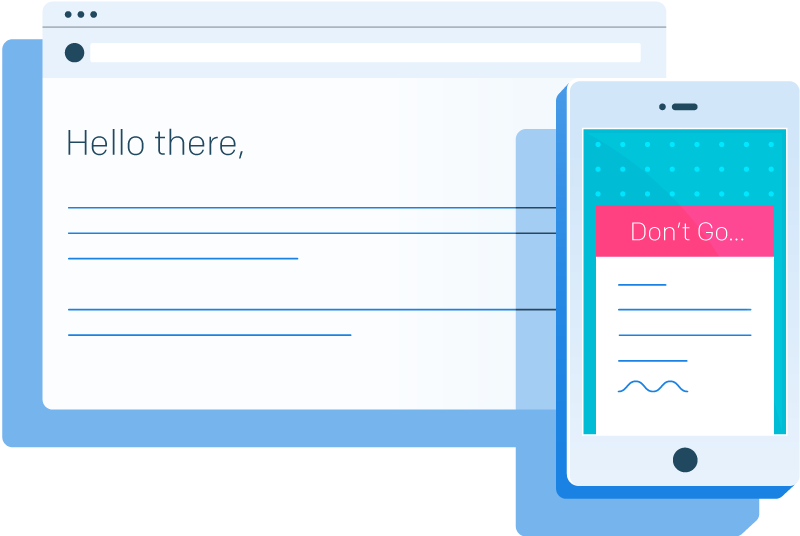 Whew! You made it through the holidays in one piece. We hope these holiday email examples are a gift you can use this year and beyond. Th
Whew! You made it through the holidays in one piece. We hope these holiday email examples are a gift you can use this year and beyond. The hard part is over, and now it’s time for you to cruise into the new year chock-full of ambition and newfound motivation. Before you do, here are just a couple of things to keep in mind as you start the new year and continue to monitor your email program.
A lot of people may sign up for your emails during the holiday season because they’re shopping for their family or significant other, not because they’re interested in your holiday offers. This can lead to an increased rate of unsubscribes and spam complaints post-holiday season.
Segmenting allows you to quickly identify cohorts of your list that signed up during the holiday season.
To help you identify who may unsubscribe ahead of time, consider segmenting your list by sign-up date and/or source.
You can then monitor the open rates and click rates for those holiday sign-ups to identify any drops in engagement after the holidays are over.
Next, if you begin to see your engagement metrics drop after the holidays, or if spam complaints increase, consider:
- Reducing your frequency to those subscribers
- Sending a targeted series of campaigns that sells your value and reestablishes why they want to continue receiving your mail
- Targeting a campaign to those subscribers that asks them to take action, like “click a link” to continue receiving your emails—this can help eliminate those who are uninterested in your mail but not willing to take steps to opt out from your list
- Establishing a tighter sunset policy for those email addresses that suppresses them after 30-60 days of no engagement
Let’s not kid ourselves: The holidays are a doozy. Though fun and magical, it can also be super stressful and ridiculously busy. Using the guidelines above will help you manage the best holiday email campaigns without going gray in the process.
Now that you’re on a roll, why not power through and continue optimizing? Check out our guide, Holiday Sending Packing List, for more comprehensive tools and technical resources that will bolster your holiday email campaign.
Need a sender for your holiday email marketing campaigns? We've got you covered with that, too.
Start a free Twilio SendGrid account and start building your email lists, creating email templates, and getting ready for the holiday madness.


 This guide will cover the following topics:
This guide will cover the following topics:
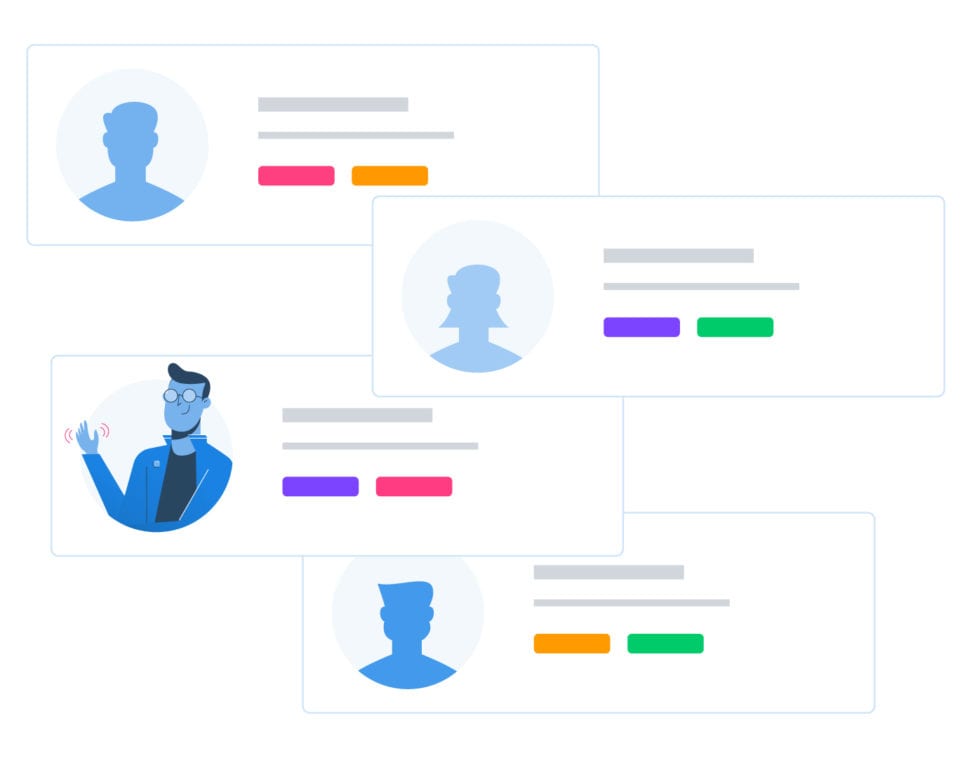 Personalize
Personalize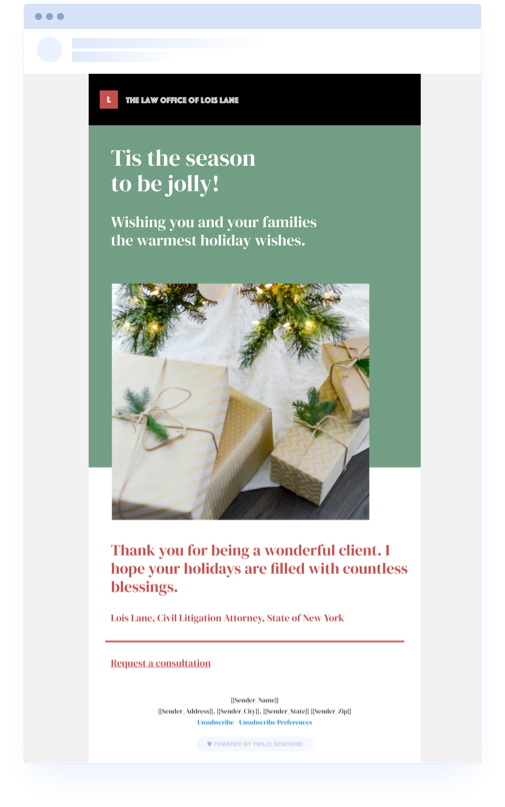 You can then send your most engaged users holiday emails a couple of hours prior to sending the emails to the remainder of your list.
You can then send your most engaged users holiday emails a couple of hours prior to sending the emails to the remainder of your list.


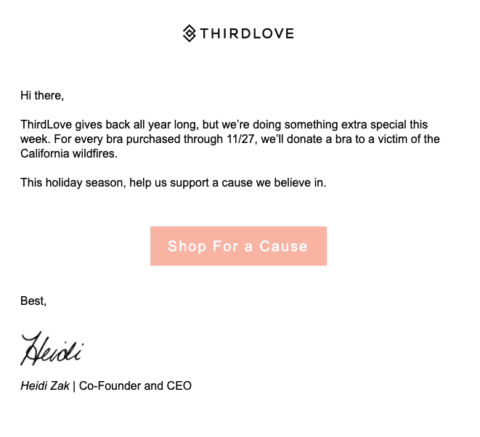 A message from the founder
A message from the founder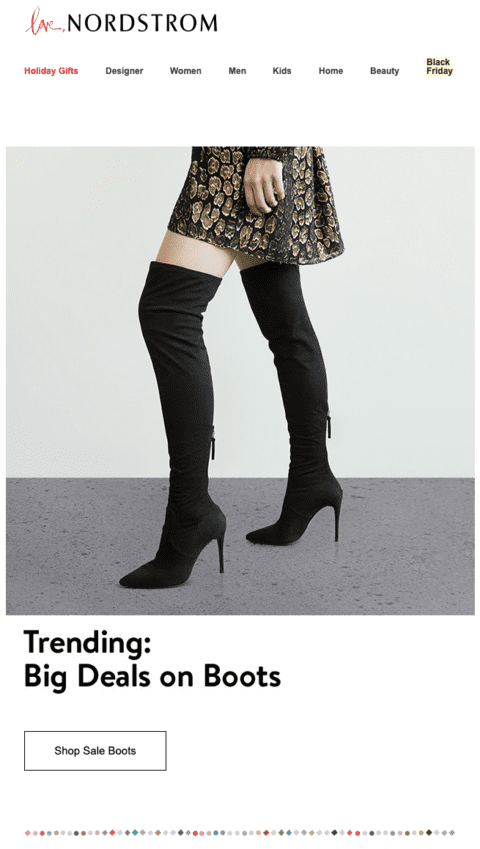 The promo email
The promo email As you get closer to the big day, the focus will shift to stocking-stuffer bargains and hot-ticket items available with quick shipping as last-minute gifts.
As you get closer to the big day, the focus will shift to stocking-stuffer bargains and hot-ticket items available with quick shipping as last-minute gifts.


 Email is a communication tool often abused by senders around the holidays. What used to be a weekly newsletter can morph into multiple daily emails.
Email is a communication tool often abused by senders around the holidays. What used to be a weekly newsletter can morph into multiple daily emails.
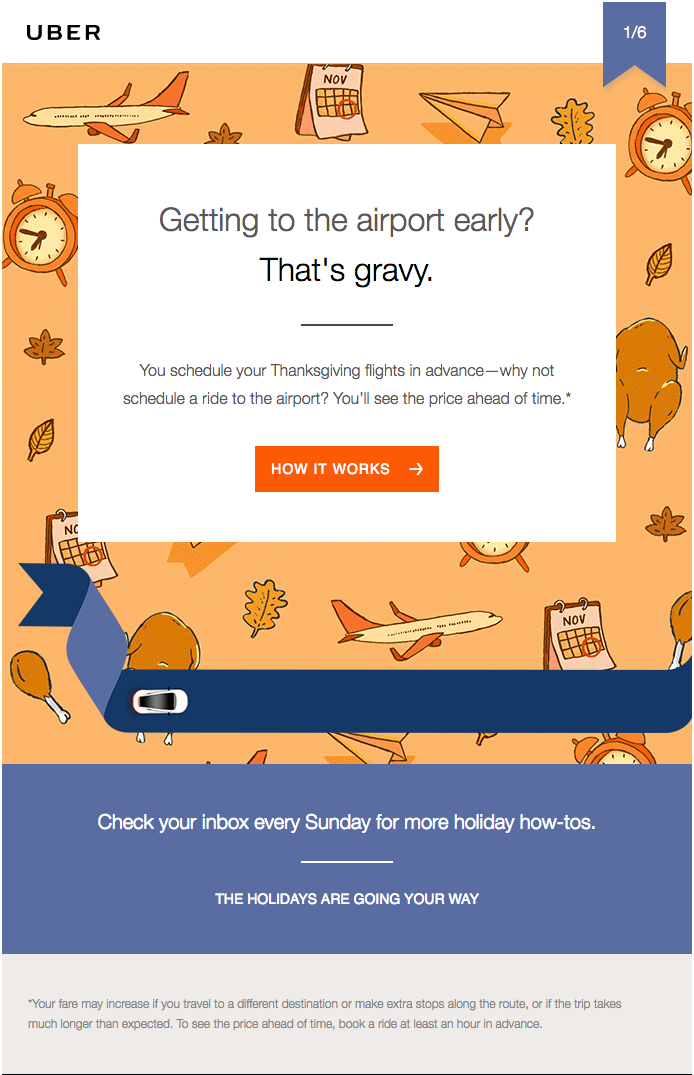
 The best holiday email campaigns aren’t always the cutest or the most fun—and sometimes that’s what’s needed the most. Backcountry went for candor over chic with this holiday expectations email, and it comes off timely and appropriate for the 2021 holiday season. Instead of fluffy promises and optimistic predictions, Backcountry gives it straight to its customers.
The best holiday email campaigns aren’t always the cutest or the most fun—and sometimes that’s what’s needed the most. Backcountry went for candor over chic with this holiday expectations email, and it comes off timely and appropriate for the 2021 holiday season. Instead of fluffy promises and optimistic predictions, Backcountry gives it straight to its customers.
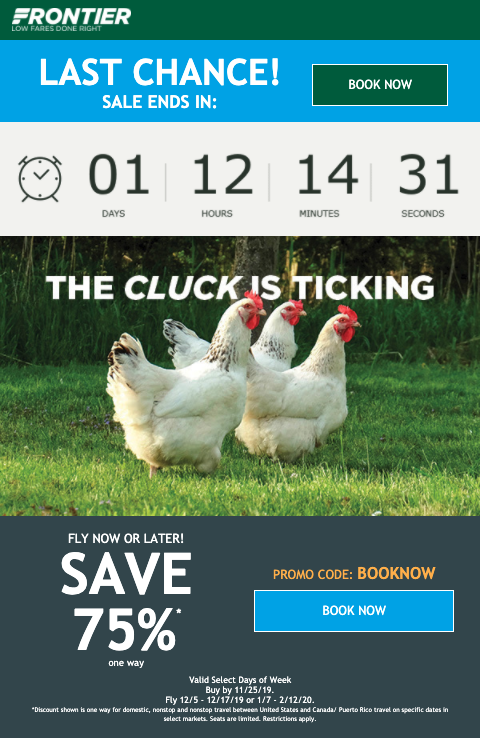
 MeUndies has some great subject lines. My favorite from last year’s holiday season was, “Keep your pants on, it’s almost Black Friday.” It’s cheeky, makes you laugh, and elicits a read. Best of all, it supports a good cause and reminds us there’s more to the holidays than gifting.
MeUndies has some great subject lines. My favorite from last year’s holiday season was, “Keep your pants on, it’s almost Black Friday.” It’s cheeky, makes you laugh, and elicits a read. Best of all, it supports a good cause and reminds us there’s more to the holidays than gifting.
 Consider staying away from the in-your-face, red-and-green flashing sale signs and the holiday email Christmas jingles. We can still have fun with the holidays without overstimulating (or sometimes annoying) our recipients.
Consider staying away from the in-your-face, red-and-green flashing sale signs and the holiday email Christmas jingles. We can still have fun with the holidays without overstimulating (or sometimes annoying) our recipients.

